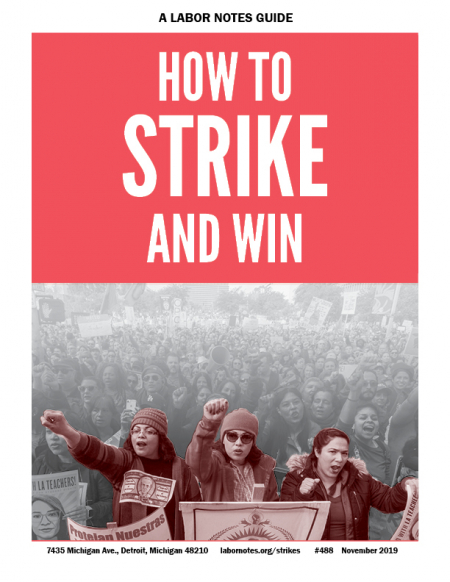Ways to Not Quite Strike

If your employer clearly wants a strike, consider an on-the-job strategy instead. Photo: UPS Teamsters United.
Strikes are the most powerful tool in labor’s arsenal, but they’re not always the right tool.
How to Strike and Win
A Labor Notes Guide
labornotes.org/strikes
The Big Picture
Know Your ABC's
Building Blocks
- Turn Up the Heat
- Organize the Organized
- Democracy: Who Owns the Strike?
- Community: Who Else Owns It?
- How to End a Strike
At a Glance
Sometimes staying on the job and fighting can be a powerful alternative—and can even catch the employer off guard. An on-the-job tactic can also be a powerful escalation step while you are building up to a strike.
Like strikes, these on-the-job strategies can grow more rank-and-file leaders and jump-start a ho-hum union. And like strikes, they are serious, risky actions that require careful preparation, unity, and wide participation to work.
If your employer clearly wants a strike, consider an on-the-job strategy instead. You might also consider the legal and strategic advantages of pushing the employer to lock you out (see here and here).
WORK TO RULE
In 2003, Verizon was ready for a strike. The company was already on the hook for extra security, 30,000 scabs, and eight months of hotel rooms… when the unions decided to work to rule instead of walking out.
Work to rule means adhering literally to the rules set out in the contract or the company handbook. It means skipping all the daily shortcuts and extras that you know the boss relies on to get the work done.
The union distributed a fact sheet that instructed workers, “Never go by memory, check your reference material” and “Never use your own judgment—ask!”
Every morning, technicians delayed the start of their day with the required 20-minute truck safety check that required two people. They refused to take trucks out without all the cones, signs, and flags required by state and federal regulations.
They followed the company protocol requiring “five points of contact” with customers before, during, and after the job—even if that meant driving back and forth between the customer’s home and the location of the problem, to give updates.
They completed their paperwork in detail. They spent extra time looking for legal parking places in busy cities where they typically parked in loading zones. Instead of borrowing a ladder from the customer, they waited for one to be delivered. Instead of making do, they drove back to the garage to pick up the special hammer they were supposed to use for a particular job. They called their managers about anything slightly tricky.
The advantages over a strike were obvious. Workers kept getting their paychecks and kept building their public campaign about Verizon’s greed and its threat to “hometown jobs” and quality service. All the while, since the unions could still strike at any moment, Verizon had to keep its expensive strike contingency plan in place.
The danger is that the employer will label the tactic as a partial strike or slowdown, both unprotected by the NLRA. The union must be careful to avoid giving the employer evidence of a coordinated or orchestrated campaign. So the campaign should be conducted covertly, with no mention in union literature. Workers should not refuse direct orders. Safety is often central to a work-to-rule campaign. West Coast dockworkers worked safe in the summer of 2003 while they fought a hard-line employer at the bargaining table.
The dockworkers’ safety concerns were real. Five members had died on the job in the six months leading up to negotiations. The ports were extra busy that year as shippers, fearing a holiday season strike or lockout, tried to rush the work.
Dockworkers pushed back by reminding each other to honor stop signs and the 15 mile-an-hour speed limit, insist on appropriate railings and earplugs, and follow protocols for operating the giant cranes. Productivity dropped dramatically. By the end of November they had a contract settlement with victories on the union’s key issues.
Working to rule has recently become a popular tactic in schools. Teachers reignited it in 2012 at Hawaii’s largest high school, just outside Honolulu. Within two weeks the tactic had spread to 51 schools across the state.

SUPPORT LABOR NOTES
BECOME A MONTHLY DONOR
Give $10 a month or more and get our "Fight the Boss, Build the Union" T-shirt.
On Thursdays the teachers would arrive exactly when school started—no early hours to plan lessons, make photocopies, or prepare for the day—and leave promptly when school got out—no afterschool tutoring, grading papers, lesson planning, supervising clubs, or planning homecoming or proms with students.
Instead, before and after school they would gather to wave signs outside their schools, along roads, and over bridges, calling for better pay. After the morning sign-waving session they would march into the school in unison.
REFUSE THE PAPERWORK
Teachers in Ontario, Canada, combined a similar work-to-rule campaign in 2015 with an administrative strike— skipping out on piles of paperwork, data entry, and standardized tests.
The teachers never took a strike off the table, but instead used these actions as stepping stones to build to a potential strike.
The goal of the paperwork strike was to pressure administrators and the government while minimizing the impact on parents and kids. It had the added benefit of forcing the province to cancel standardized tests—which students and teachers alike despised—for the year.
In the same spirit, bus drivers in Winnipeg, Canada, have held two fare strikes so far this year. They couldn’t tell passengers the ride was free, but on certain days they chose to say nothing if a passenger boarded without paying. In advance, the union publicized the upcoming fare strike in the news, on social media, and by leafleting at bus stops. Management hated it.
Transit agencies typically try to pit passengers and workers against one another—“To raise her pay, we’ll have to raise your fare!” The fare strike turned the tables, making allies and highlighting the two groups’ common interest in frequent, affordable, and accessible public transit.
BOYCOTT OVERTIME
One more way workers can almost strike, while staying on the job, is to boycott overtime.
Nurses and paramedics in a hospital emergency department escalated to this tactic in 2013 to force the issue of chronic short staffing.
For two years the nurses had tried many forums—committee meetings, petitions, even confronting an administrator at the holiday party—to urge the right solution: hire more nurses. Instead, the hospital constantly relied on its existing staff to work copious overtime.
The nurses decided they weren’t going to prop up this bad system anymore. On a certain week, they agreed, no one would sign up to work more than their regular shifts.
Management thought it was a bluff— until the chaotic week began. It wasn’t easy for nurses to stand firm while patients waited longer than ever and supervisors pleaded. But two days in, management gave in and agreed to expedite the hiring of more nurses—a win for patients and staff.
For UPS Teamsters in Rhode Island, the breaking point came in 2017. Drivers already expect to work 60-hour weeks during the intense holiday season. But that year, a few weeks before Christmas, UPS announced it was exploiting a regulatory loophole and upping drivers to a 70-hour week.
Drivers knew UPS had a weakness. During the holiday season the company relies on drivers to volunteer for an early start on Mondays to get a jump on delivering packages that came in over the weekend.
Usually most are happy to do it. But December 11, a Monday morning, found UPS managers in the parking lot facing hundreds of Teamsters chanting “We won’t work 70!”
They stayed put, refusing the early start. That night tens of thousands of packages came back to the building undelivered. It would take UPS days to catch up.
The company backed down and the Teamsters kept their 60-hour week.
But under the law, refusing overtime as a group is a strike. If done during the contract, workers can be fired; if it's expired, they can be permanently replaced. Once again, the campaign should be conducted covertly, with no mention in union lit or at meetings.





